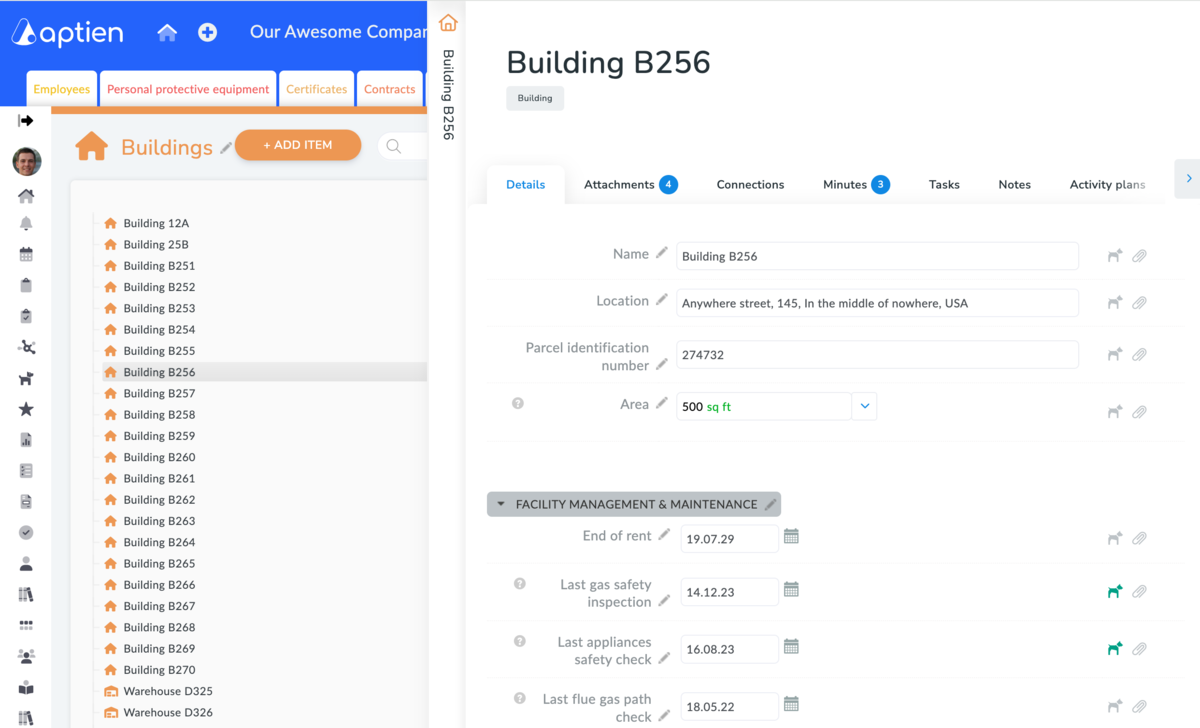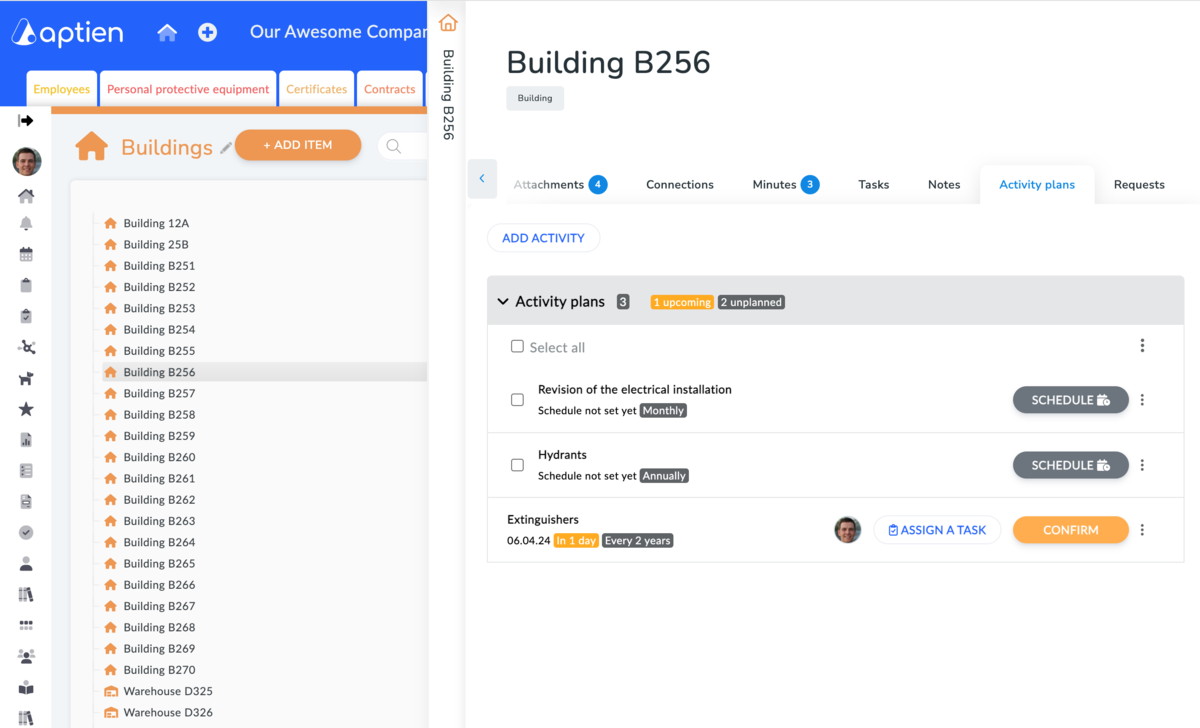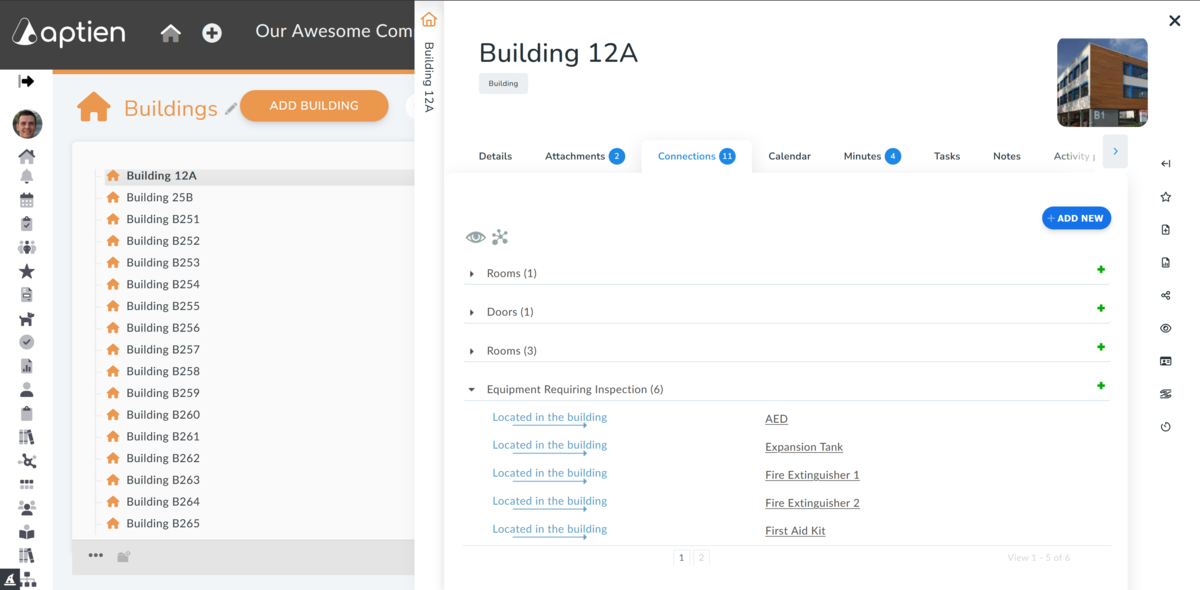The Building Organizer in Aptien is designed for company facility managers, building managers, operations managers, and other professionals responsible for company buildings and facility management.
Overview: Keep Track of All Your Buildings and Facilities
With the Building Organizer, you can easily manage a complete list of your company's buildings and facilities, including key details like leases, equipment, security systems, and maintenance records. If needed, you can link it with the Rooms Organizer to monitor security for individual rooms.
Key information you can track:
- Name or identification of each building
- Building maintenance and tracking of inspection deadlines
- Doors located in the building (linked from the "Doors" Organizer)
- Scheduled inspections with automatic reminders
- Additional details about building features and assets
Room Overview
- If your situation requires managing individual rooms within your buildings, use the Room Organizer template.
Building Equipment Overview
- If your situation requires tracking your equipment, we recommend using the template for equipment requiring inspection and inventory.
Simplifying Building-Related Inspections and Compliance
The organizer makes it easy to manage building inspections, ensuring you stay compliant with safety regulations and can easily track inspection activities.
Here's what you can do:
- Create Inspection Checklists: Make customized checklists to guide building inspections.
- Plan and Schedule Inspections: Plan and assign inspection tasks effortlessly.
- Confirm Completed Inspections: Track and verify when inspections are completed.
- Store Inspection Reports in One Place: Keep all inspection documents organized and easily accessible.
Default types of Regular Building Inspections:
- HVAC Inspection – Regular checks of heating, ventilation, and air conditioning systems to ensure proper operation, efficiency, and air quality, as well as to prevent system failures.
- Fire Safety Inspection – Ensures that fire alarms, sprinklers, extinguishers, emergency exits, and other fire safety systems are functioning correctly and comply with safety regulations.
- General Safety Inspection – A broad inspection covering overall building safety, including lighting, stairways, elevators, emergency signage, and general maintenance to identify potential hazards.
Examples id Building-Related Inspections and Checks
- HVAC Inspection – Regular checks of heating, ventilation, and air conditioning systems to ensure proper operation, efficiency, and air quality, as well as to prevent system failures.
- Fire Safety Inspection – Ensures that fire alarms, sprinklers, extinguishers, emergency exits, and other fire safety systems are functioning correctly and comply with safety regulations.
- General Safety Inspection – A broad inspection covering overall building safety, including lighting, stairways, elevators, emergency signage, and general maintenance to identify potential hazards.
- Emergency Lighting and Exit Signs: Battery backup function and bulb status.
- Electrical System Inspection: Panels, breakers, wiring, grounding, and bonding
- Elevator Inspection: Safety mechanisms, controls, cab functions.
- Plumbing System Inspection: Backflow prevention devices (annual), water heaters, supply lines, drainage.
- Backflow Preventer Test: Protects water supply from contamination.
- Fire Door Inspection: Door closures, gaps, latching mechanisms.
- Building Façade Inspection (for taller buildings): Structural integrity of exterior walls, windows, balconies.
- Roof Inspection: Membrane condition, flashing, drainage.
- Security Systems (Access Control, Burglar Alarms): Cameras, alarms, access readers, battery backups.
- Gas Lines and Appliances: Leak detection, appliance vents, shut-off valves.
- Carbon Monoxide Detectors: Placement, battery function.
- Energy and HVAC Efficiency Audits: Insulation, control systems, energy usage.
How to create Building Inspection Checklist
- Open the specific building's record
- Click on the "Activity Plans" tab (to see it, you must have permissions set for your role)
- If you don't find the inspection you need, click the "Add Activity" button.
- Name the inspection to be performed (e.g., Electrical Inspection) by entering the name into the "Activity Name" field.
- Set the inspection as a recurring activity.
- Choose the recurrence period according to law or manufacturer's recommendation.
- Select which equipment the inspection applies to.
- Optionally, assign the inspection to a group.
- Save
Managing Building Equipment Inspections
- You can easily add additional inspections to a checklist using the process mentioned above
- For tracking inspections and maintenance of other portable equipment, such as fire extinguishers and pressure vessels, we recommend using the "Equipment for Inspection" organizer
- Using connections, you can view the equipment linked to a specific building directly within the "Connections" tab. This ensures you always have a complete overview of all equipment assigned to that building.
- The "Equipment for Inspection" register also allows you to store all documentation for specific equipment.
Managing Building Security with the Organizer
If building security is a concern, you can use the Building Organizer together with other organizers like Rooms, Doors, Keys, and Access Cards.
- Building-Level Security: Track information about security systems, alarms, and physical barriers.
- Room-Level Security: Use the Rooms Organizer to track locks, access systems, and issued keys.
- Door-Level Security: If needed, use the Doors Organizer for detailed tracking of building access points.
- Key and Access Card Tracking: Use the Keys and Access Cards Organizer to track who has which keys or cards.
By using the Building Organizer alongside related organizers, you can streamline how you manage your company's physical assets, maintenance activities, and building security.


